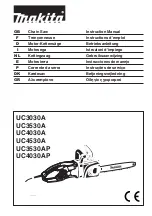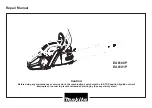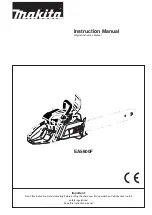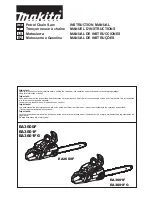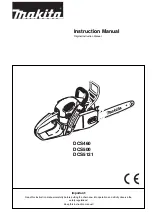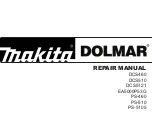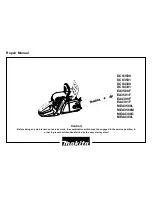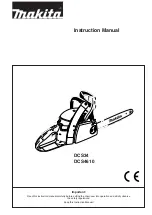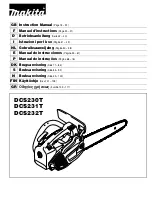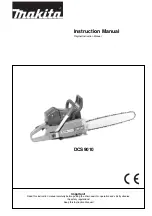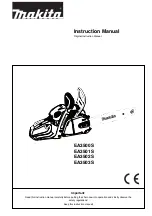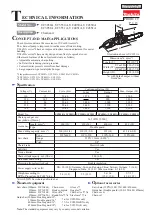
moved smoothly but is still closely seated (Fig. 5/pos. X2). Increase the tension by turning the bar
fastening pin (Fig. 2/pos. B) in a CLOCKWISE DIRECTION.
•
When the saw chain is correctly tensioned, hold the tip of the bar upwards and completely tighten the bar
fastening pin (Fig. 2/pos. B).
•
Secure the side cover (A) with the bar mounting nuts (11), by using the spark plug spanner (19) (Fig. 7).
•
A new saw chain stretches, requiring adjustment after as few as 5 cuts. This is normal with a new chain,
and the interval between future adjustments will lengthen quickly.
•
If the saw chain is TOO LOOSE or TOO TAUT, the drive wheel, chain bar, saw chain and crank shaft
bearing will suffer premature wear. Fig. 5/pos. X2 shows the correct tension (when cold) and Fig. 5/pos.
X3 shows the tension (when warm). Fig. 5/pos. X1 shows a chain that is too loose.
5) Chain brake mechanical test
Your chainsaw is equipped with a chain brake that reduces the possibility of injury due to kickback. The chain
brake is activated if pressure is applied against the chain brake lever (3) when, as in the event of kickback, the
operator’s hand strikes the lever. When the chain brake is actuated, saw chain movement stops abruptly.
The purpose of the chain brake is to reduce the possibility of injury due to kickback; however, it cannot provide
the intended measure of protection if the chainsaw is operated carelessly. Always test the chain brake before
using your saw and periodically while on the job. (See below for details of how to perform a test of the chain
brake).
6) To test chain brake (Fig. 8)
a) The chain brake is DISENGAGED (chain can move) when the CHAIN BRAKE LEVER (3) IS PULLED
BACK AND LOCKED (pos.1).
b) The chain brake is ENGAGED (the chain is locked) when the chain brake lever (3) is pulled forward (pos.
2). It should not be possible to move the saw chain.
The chain brake lever (3) should snap into both positions. If strong resistance is felt, or the lever does not
move into either position, do not use your chainsaw. Take it immediately to a professional Service Centre for
repair.
6.2 FILLING/CHECKING THE LUBRICATING OIL (FIG. 9)
Following oil types are recommended:
Recommended Oil Type
Season
Temperature
Oil Type
Summer
25 °C or higher
SAE 10W-30
Spring/Fall
10 - 25 °C
SAE 10W-20/30
Winter
10 °C or lower
SAE 10W-10
a) Position the chainsaw in a way that the lubrication oil tank (15) faces upwards.
b) Open the cap of the lubrication oil tank (15) and check the oil level. If the oil level is more than 1-2 cm
below the screw thread, please fill the lubrication oil tank (15).
c) Do not overfill and leave approximately 5 mm space between the top of the oil and the inside edge of the
lubrication oil tank (15) to allow for expansion.
d) Tighten the cap of the lubrication oil tank (15) firmly.
1) Filling/Checking the chain oil (Fig. 10)
Check the level of chain oil in the chain oil tank (17) before each use of the chainsaw. It is recommended to
use standard chain oil.
a) Position the chainsaw in a way that the chain oil tank (17) faces upwards.
b) Open the cap of the chain oil tank (17) and check the oil level. If the oil level is more than 1-2 cm below
the screw thread, please fill the chain oil tank (17).
c) Do not overfill and leave approximately 5 mm space between the top of the oil and the inside edge of the
chain oil tank (17) to allow for expansion.
d) Tighten the cap of the chain oil tank (17) firmly.
16
Summary of Contents for RAC49CS4T
Page 9: ...5 KNOW YOUR PRODUCT 5 1 LAYOUT 9 ...
Page 11: ...6 SET UP OPERATION 11 ...
Page 12: ...12 ...
Page 13: ...13 ...
Page 30: ...NOTES 30 ...
Page 31: ...NOTES 31 ...
Page 32: ...BUILDER SAS 32 rue Aristide Berges Z I du Casque 31270 Cugnaux France MADE IN PRC 2021 ...































